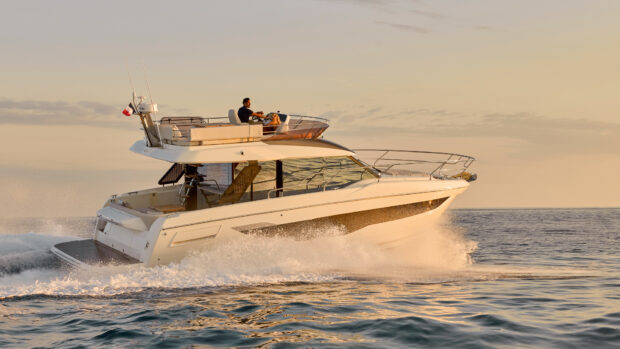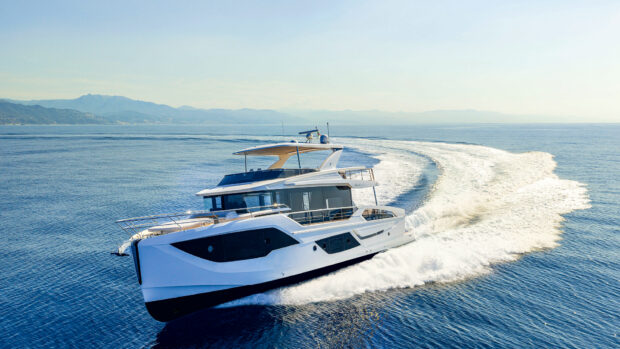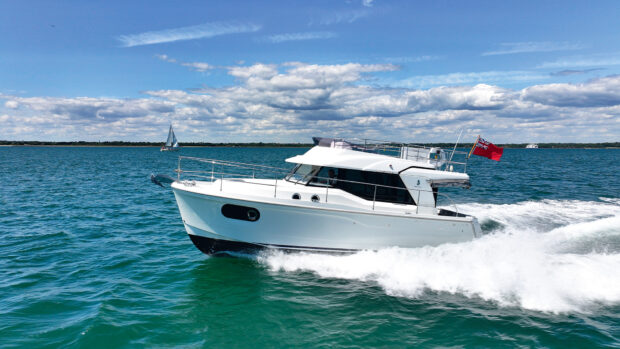The Azimut 40 manages to pull off a startling trick: It's a 40-footer with the look and feel of a much bigger animal
It’s not often that a new boat from a mainstream production builder can take you by surprise.
But step into the cockpit of the new Azimut 40 and the immediate impression is that you have inadvertently wandered aboard the next boat up in the range.
Either that, or Azimut have been raiding the parts bins of their venerable 46 and have copied all the best ideas from their splendid 50.
Whatever the reason, the Azimut 40 has tremendous gravitas, and there is a clear sense of being on board a boat that is larger and more expensive than the typical 40-footer.
Two things are responsible for this impression. One is the sheer scale of some of the details – the huge and immensely practical mooring bitts in the cockpit corners and the oversized chromed handrails in the saloon, for instance.
There is also the great width of the Azimut 40: at 13ft 10in (4.22m) it is considerably beamier than the 13ft 0in-wide (3.96m) Fairline Phantom 40, and only 2in (50mm) narrower than the Princess 45.

There is good headroom throughout the Azimut 40, with 6ft 4in (1.93m) in most areas, including the owner’s cabin.
The calibre of the detail leaves its mark too. The Azimut 40 is not the only boat to fit a costly hi-lo folding dining table where you would sometimes find a cheaper and less versatile fixed affair, but how many boats in its class provide the expensive luxury of a precise, electrically powered mechanism to raise and lower the tabletop?
And how many of its competitors fit as standard power steering, a £2,000 autopilot, a £1,000 water black holding tank, a £7,000 generator, or a wonderfully expensive foldout cockpit table?
Azimut clearly took their accountants out boating- and threw them overboard.
Beyond recognising that it’s impossible to squeeze any more than the customary pair of cabins and heads into a 40-footer, Azimut seem determined to ignore the fact that this is, by their standards, a small flybridge boat.
Driving the Azimut 40
The Azimut 40’s top speed was also a surprise. Just as with their 42 Azimut have produced an unexpectedly efficient hull.
According to Azimut, the 40 powered by a pair of 380hp Cummins will nip along at 31 knots.
This is very respectable, and assuming the rival UK boatbuilders’ own speed estimates are correct (and they do tie in very closely with MBY‘s test data), buyers wanting to match this speed in one of the slimmer British boats will have to fit bigger engines.
However, this useful efficiency only manifests itself at high speed.
Not surprisingly, the Azimut 40 can’t escape its bulk entirely, and our test figures suggest that if you intend to cruise in the low to mid-20s, the British boats will travel further on every gallon of diesel.

Azimut also build large and very expensive flybridge boats – they just forgot that the Azimut 40 is not one of them.
With one notable exception, the driver’s lot is generally fine.
It’s difficult not to be impressed by the Azimut 40’s extravagant glamour – the two steering wheels exude an opulence that makes a typical offering seem cheap in comparison, and the deeply sculpted silver and blue dash exudes class.
But the Azimut 40 has stiff competition in this department, with Fairline, Sealine and Princess all providing plainer-looking but excellent helm positions, which either match or better the Azimut for function.
And that’s principally because all these rival boats have something the Azimut 40 conspicuously lacks: a comfortable, supportive, adjustable lower helm seat.
I can’t see how a fixed seat is acceptable on any boat at any price.
Not only are we all different shapes and sizes, we have different needs too; women almost always sit much closer to the controls, for instance.
It’s a baffling choice for Azimut to have made – a clumsy feature seemingly at odds with the lavish, money-no-object feel pervading the rest of the boat.

Stuck on you: the Azimut 40’s stylish helm position is let down by its fixed helm seat.
Fortunately, the flybridge helm seat in contrast is large, comfortable and supportive, and runs on sliders.
The flybridge dash is simple but clearly laid out, and there’s an invaluable detail I have yet to see elsewhere: a deep sliding drawer for odds and ends by the helmsman’s right leg.
Sadly, our normal trials were severely curtailed. Our boat had a perspex floor in the saloon with a big hole through to the engineroom (for boat show display purposes), so taking noise readings would have been fruitless.
Our trim tabs had malfunctioned too, leaving one fully up and one partly down.
This meant our boat ran along with a permanent list that would have made a nonsense of any speed and trim figures – although seemingly not for the other journalists on board.
For this reason, the speed and fuel consumption figures in our Datafile are based on Azimut’s figures.

Speed and fuel consumption figures.
Despite the Azimut 40’s starboard lean and its inconsistent cornering, it clearly had a similar generic feel to the other Azimut flybridge boats I’ve tested – the 39, 42, 46, 50 and 55.
What I was expecting was exactly what I got: a boat resolutely set in the comfy cruiser mould.
But however efficient its 31-knot hull, the Azimut 40 can’t escape the limitations of its beam and bulk, so even with the impressive power steering, don’t get handling as sharp or as speedy as the leaner Fairline Phantom 40, or the same ride as a Princess 42 with its deepervee hull.
You won’t be disappointed as long as you don’t expect the aquatic equivalent of a BMW MS; think Lexus RX300 and you’re closer.
On deck
Thankfully, Azimut have once again utilised my favourite cockpit mooring gear arrangement of a pair of oversized exposed bitts alongside multi-directional fairleads on the transom corners.
With no fiddly, damage-prone covers to deal with, they are supremely easy to use.
When you’re cruising short-handed, the warps can be left conveniently pre-coiled and hanging on the bitts as you approach the mooring.
And the upright stems on the bitts are ideal for hooking pre-tied fender loops onto, so you can quickly hang a couple of fenders around the vulnerable transom area.

Bitts and pieces: the huge mooring bitts are a feature usually found on larger boats.
The spring cleats are a good size, although a second pair would be welcome for mooring alongside.
At the other end, the arrangement is straightforward with a self-stowing anchor handled by an electric windlass.
Three good touches here are the chain wash, the stainless wear-strips alongside the mooring cleats, and the separate chain hopper that stops the anchor chain getting tangled with the fender tails.
When it comes to moving around safely and quickly, this boat is amongst the best in its class.
The superstructure of the Azimut 40 slopes inwards and the teak-laid decks are 11in (280mm) wide, so negotiating the side decks is safe and easy.
The central passerelle arrangement is excellent, with Azimut dipping the seat-back and providing a removable cushion where your foot falls on the seating.
There’s only a shallow incline on the teak steps to the flybridge, with a handrail running top to bottom.
And aside from the single low point behind the helmsman’s seat, at 30in (760mm) deep the flybridge feels very secure.

To the right of the dash is a locker and windscreen water reservoir.
Only one wish -if you moor alongside a pontoon, ask UK agents Med-Sale to fit flat teak treads onto the aft corners of the bathing platform, otherwise you could end up skidding
off the slippery fibreglass when you try stepping onto the platform.
Stowage in the cockpit is good with six lockers in all: three general purpose, one for the fridge, one with the shower and the shore-power connection, and the safety locker, which houses the bilge pump and the manual overrides for the engineroom fire-extinguishers.
There’s more useful stowage on the flybridge too, under the seats in moulded lockers.
Of course, the deck stowage needs to be good because combining the engineroom and lazarette leaves the Azimut 40 without the considerable benefits of the separate lazarette that all its British rivals provide.
Azimut’s knockout idea is the excellent cockpit table, which hinges away beneath the cockpit seats when you are under way.
Because it remains connected to the boat it appears, if not magically or electrically, with far less effort than a loose, heavy table would from the bowels of a locker.
Accommodation
Azimut have moved away from the previously ubiquitous high-gloss American cherry joinery that so many other boatbuilders still use.

Twice as nice: the inboard berth slides across to form a large double.
Of course, appreciation of style is entirely subjective, but whatever your taste it’s probably refreshing to see something different.
Although it is only 40ft 10in (12.45m) long, thanks to its considerable beam, its lighter cherry finishes and its generous headroom, the Azimut 40 feels roomy inside, on a par with its longer competitors like the Princess 42 and Sealine F42/5.
As long as you are no taller than 6ft 4in (1.93m) you should find that all the berths and cabins will accommodate you just fine, sometimes with room to spare.

Highs and lows of cruising: the folding saloon table has an electrically powered mechanism for raising and lowering.
lt’s difficult to produce anything truly original within the bounds of this formulaic but eminently workable twincabin, twin-ensuite-heads layout.
Instead Azimut have wisely concentrated on the detail.
For instance, the galley has an unusual but excellent solution: non-slip rubber linings inside all the drawers and lockers that will prevent the contents from sliding and crashing around.

Practical magic: drawers and lockers have non-slip rubber linings in the excellent galley.
There are plenty of useful fiddled countertops in the saloon, and Azimut have engineered a beautiful three-tier drawer to house crockery adjacent to the dining table, although there’s no positive lock to keep the drawers shut tight in bouncy conditions.
The spacious heads/shower compartments boast classy shower fittings, and all the Azimut 40’s light switches are at waist level so even the kids can operate them.
The doors have rubber perimeter seals to cut down noise and stop the doors rattling -a detail you usually only find on more expensive boats.
Engineering and construction
Our experience with Azimut’s other boats suggests that their unusual habit of combining the engineroom with the lazarette doesn’t result in increased noise levels; the sound doesn’t boom out through the cockpit floor.
Despite our lack of sensible sound readings, I’d expect the Azimut 40 to have par-for-the-course noise levels.
An area where the Azimut 40 differs considerably from its competitors is in its construction.
Most significantly, the hull is built using vacuum-bag resin-infusion techniques.
There are a slew of benefits for the builder and the environment; for the owner there’s the promise of a stronger and consistent laminate quality.
For the first time, Azimut have also utilised a fully moulded structural hull liner, a smoothly finished alternative to the usual laminated stringers.
They also use a Vinylester skin coat, which is more expensive but physically tougher and more osmosis resistant- hence Azimut’s comforting five-year osmosis warranty.
The Azimut 40’s build quality is as good as it gets.
The engineering installation does not appear notably better or worse than its rivals; what catches your eye are the small details.

Easy does it: the combined engineroom / lazarette provides good access to all the machinery and steering gear.
The steps into the engineroom are non-slip plastic plates -on many boats they are slippery stainless ladders.
Inside, there’s a light on a long (and very useful) pre-tensioned wandering lead.
And in place of the single large clear-bowl fuel filters, there’s the option of dual Racor filters with emergency switch-over valves – essential in cruising areas with dodgy diesel.
Azimut are one of the few builders whose fuel fillers are sited inside recessed overflow reservoirs in the side decks to stop you getting diesel splashes on that fine teak.
Azimut 40 verdict
The Azimut 40 presents the UK builders with an interesting challenge.
There’s no doubt that the Brit pack have three excellent boats in the Sealine F42/5, the Princess 42 and the Fairline Phantom 40.
And notwithstanding the unfortunate limitations of our test.
I think there’s little doubt that the Azimut 40 is unlikely to provide the same sharp-edged handling as the Phantom 40.
Indeed, you shouldn’t expect such an obviously voluminous boat to challenge Fairline’s slimmer and lighter boat in this department – you wouldn’t think of hustling an S-class Mercedes saloon in the same way as their SL coupe.
The Azimut 40 also lacks a separate lazarette and the essential comforts of an adjustable lower helm seat – benefits that all three British boats provide.
However, in every other department, the Azimut 40’s star shines very brightly.
With its expensive Vinylester skin coat and advanced resin-infused and vacuum-bagged hull laminate. the quality of the 40’s construction is second to none, and reliable enough for Azimut to offer a five-year anti-osmosis warranty.
It has a better than average top speed, a wonderfully practical cockpit design, and despite its shorter length, a sturdy big-boat feel outside that easily rivals its longer competitors from Sealine and Princess.
As an owner though, what will bring a big grin to your face is the irrepressible feeling that Azimut took all their accountants out boating one day, and tossed them to the sharks.
The costly Vinylester skin coat. the power steering, the electrically operated saloon table, the oversized mooring bitts and the expensive fold-out table in the cockpit… these are not the signs of a bean-counter.
The same charitable folk also forgot that autopilots and generators invariably reside on the options list.
Of course, Azimut also build extremely large and very expensive flybridge boats – they obviously just forgot that their new 40 is not one of them.
First published in the March 2005 issue of MBY.
Pros
- The look
- Big-boat feel
- Superb cockpit design
- Build quality
- Top speed v horsepower
- Size of flybridge
- Headroom & berth size
- Excellent detailing
- Mooring arrangements
- Resin-infusion techniques
Cons
- No separate lazarette
- Fixed lower helm seat
- Bathing platform access
Details
Price from: €375.000 ex works (twin 380hp); approx £300,000 inc UK VAT
Price as tested: as above
Overall length: 40ft 10in (12.45m)
Hull length: 38ft 3in (11.65m) MBY estimate
Beam: 13ft 10in (4.22m)
Displacement: 12.5 tonnes light, 13.9 tonnes loaded (loaded = light + 100% fuel & water)
Draught: 2ft 8in (0.80m) lo keel
Air draught: 15ft Sin (4.70m)
Fuel capacity: 242 imp gal (1,100 litres)
Water capacity: 110 imp gal (500 litres)
Deadrise angle: 14 degrees at the transom
RCD category: B (for 10 people)
Designers: Exterior: Stefano Righini. Interior: Carlo Galeazzi, 2004
Contact: Med-Sale UK
Tel: +44 (0)1489 565555
Websites: www.medsale.net / www.azimutyachts.net









